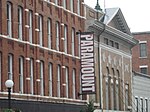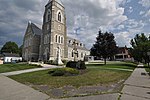Immaculate Heart of Mary School (Rutland, Vermont)
1950s architecture in the United StatesBuildings and structures in Rutland, VermontInternational style architecture in VermontNRHPweekly errorsNational Register of Historic Places in Rutland County, Vermont ... and 1 more
School buildings on the National Register of Historic Places in Vermont
The Immaculate Heart of Mary School is a historic school building at 10 Lincoln Avenue in Rutland, Vermont. Built in 1951, it is a rare example of International style architecture in the state, designed by Dirsa & Lampron of Manchester, New Hampshire. It was listed on the National Register of Historic Places in 2020.
Excerpt from the Wikipedia article Immaculate Heart of Mary School (Rutland, Vermont) (License: CC BY-SA 3.0, Authors).Immaculate Heart of Mary School (Rutland, Vermont)
Lincoln Avenue, Rutland Town
Geographical coordinates (GPS) Address Phone number Nearby Places Show on map
Geographical coordinates (GPS)
| Latitude | Longitude |
|---|---|
| N 43.608888888889 ° | E -72.975555555556 ° |
Address
Immaculate Heart of Mary Roman Catholic Church
Lincoln Avenue 18
05701 Rutland Town
Vermont, United States
Open on Google Maps








